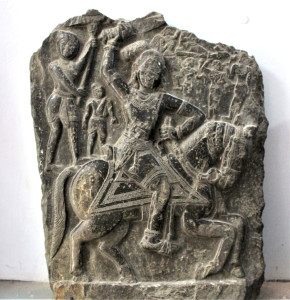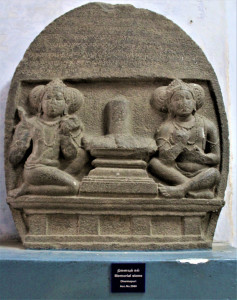Registered with the Registrar of Newspapers for India under R.N.I 53640/91
Vol. XXVIII No. 13, October 16-31, 2018
Our Museum’s wealth
Hero-stones, less known sculptures

Hero-stone, Ipuru, Guntur District, Andhra Pradesh.

Memorial stone, Tagadur, Dharmapuri District, Tamil Nadu.
The supremely beautiful stone sculptures of deities datable to various dynasties in India are the pride of the Government Museum, Chennai. Visitors stand in awe of the superb workmanship and try to identify the names of the deities, many of which they know, and some of which they don’t. The same visitors do not care to look at other stone slabs, which too have carvings – not of deities, but of men. Somehow these have no fascination for the onlooker. We suppose it is because they know not what these are. They are hero stones and memorial stones, many of which are on display on the first floor of the main gallery.
Hero stones, called Nadukal in Tamil, usually have a sculpture of a man who died while fighting on the battlefield or in some other selfless act of bravery. These men are shown holding weapons, usually a bow and arrow, and riding on an elephant or on a horse and fighting with enemies. An inscription seen at the top of the slab will contain the relevant information about the hero and his gallant acts. Many hero-stones also show apsaras or celestial women above the battlefield to receive those who died in war and to take them to heaven or Vira-swarga. Some hero-stones also have tiny carvings of the sun and the moon on top, indicating that the fame of the hero will last till forever. Sometimes, a Shiva Linga is also depicted at the top, if the person who died was a Shaivite. The Museum has hero stones from many places including erstwhile North Arcot, South Arcot and Salem Districts of Tamil Nadu and areas in Karnataka and Andhra Pradesh too.
One hero-stone is from Chippagiri in Karnataka. Dated to around the 10th Century C.E., this carving is in three clearly demarcated horizontal sections. Prominently seen in the lowermost panel are two warriors, each on a galloping horse. The man on the left holds an upraised sword, while the other has a lance in his right hand. Below the horses can be seen a few corpses to show that this is a battlefield. The panel above this scene has a man carved in the middle flanked by two apsaras holding him and fanning him with fly-whisks. This is to show that the hero has ascended to heaven. On the topmost panel, which is slightly damaged, are seen a Shiva Linga with a seated figure in prayer on one side and a person standing on another.
Another hero-stone in a fairly good condition, albeit slightly damaged at the top, is from Ipuru in Guntur District, Andhra Pradesh. This has a man riding on a horse with his left hand holding the reins and the right hand held above his head holding an upraised sword. Two men stand behind him, the taller one holding an umbrella. A few women seen in the background are obviously apasras waiting to receive the hero and accompany him to Vira-swarga.
Apart from the numerous hero-stones in the Museum, there are a few memorial stones on display. These are slabs which have been set up in memory of a person, usually a king or chieftain, by their relatives and worshipped. An eye-catching hero-stone datable to the 8th Century C.E. is from Tagadur, Dharmapuri District, Tamil Nadu. This stone slab, flat at the bottom and curved at the top, has a Shiva Linga in the centre with two men on either side. Above these deeply cut figures is an inscription in the Kannada script of the 8th Century. This interesting epigraph records that this slab, which was set up in the temple of Bhogishwara in Tagadur, was in memory of Vidyarasi, a well-known Shaivite teacher of the Pasupata sect of Shaivism who is praised in this record. The other man in this carving is his student. The distinctive hairstyle of these two personages have been well sculptured in this unusual panel.
Another memorial stone on display belongs to the 10th Century C.E. Though the provenance is not known, it depicts a vibrant battle scene with the king prominently carved in the centre on horseback, fighting with a sword. Around him are numerous foot-soldiers holding spears. The horse is seen crushing an enemy underfoot. The attire, headgear and weapons of the times can be clearly seen from this well-preserved carving.
Yet another prominent hero-stone is from Kambaduru in Anantpur District, Andhra Pradesh, datable to the 10th century C.E. Although damaged around the side, this slab has the figures of a ruler and his wife, standing on a platform, clearly carved in the centre. The king stands with his palms pressed together in prayer with a sword resting on his left shoulder. Decorated with a long garland hanging down almost to his ankles, he is seen with many ornaments. Above the couple are sculpted a Shiva Linga with a Nandi in front.

